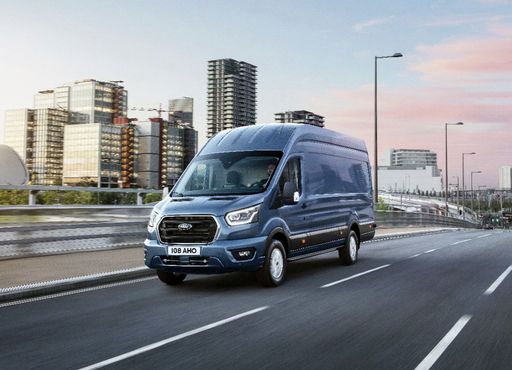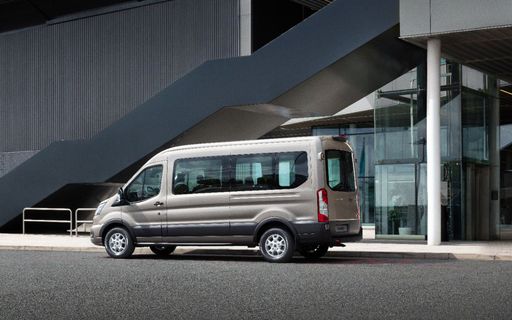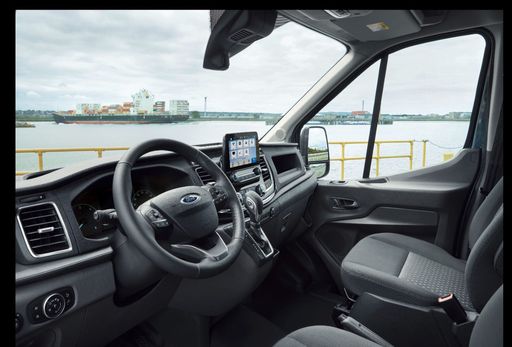Ford Transit Bus VS Mercedes Citan – Specs, Efficiency & Price Comparison
Find out now which car fits your needs better!
The Ford Transit Bus (Bus) is powered by a Diesel engine and comes with a Automatic transmission. In comparison, the Mercedes Citan (High Roof Estate) features a Petrol, Diesel or Electric engine and a Manuel or Automatic gearbox.
When it comes to boot capacity, the Ford Transit Bus offers 0 L, while the Mercedes Citan provides 551 L – depending on what matters most to you. If you’re looking for more power, you’ll need to decide whether the 150 HP of the Ford Transit Bus or the 131 HP of the Mercedes Citan suits your needs better.
There are also differences in efficiency: 9.40 L vs 19.30 kWh5.30 L. In terms of price, the Ford Transit Bus starts at 50500 £, while the Mercedes Citan is available from 21900 £.
Compare all the key specs now and find out which model fits your lifestyle best!
Ford Transit Bus
The Ford Transit Bus is renowned for its robust performance and spacious interior, making it an ideal choice for both commercial and personal use. With its efficient handling and modern design, it effortlessly combines practicality with comfort. Its adaptability and versatility ensure it meets the demands of various driving needs, from urban transport to long-distance journeys.
details @ media.ford.com
@ media.ford.com
 @ media.ford.com
@ media.ford.com
 @ media.ford.com
@ media.ford.com
Mercedes Citan
The Mercedes-Benz Citan High Roof Van is a versatile option in the compact van segment, offering a perfect blend of practicality and style. Its sleek design combined with the brand's hallmark attention to detail ensures that it stands out on city streets and motorways alike. Inside, the spacious cabin provides ample room for passengers or cargo, making it an ideal choice for both urban professionals and families seeking flexibility.
details

|
|
|
|
|
Costs and Consumption |
|
|---|---|
|
Price
50500 - 52900 £
|
Price
21900 - 32400 £
|
|
Consumption L/100km
9.4 - 9.5 L
|
Consumption L/100km
5.3 - 7.1 L
|
|
Consumption kWh/100km
-
|
Consumption kWh/100km
19.3 - 20.7 kWh
|
|
Electric Range
-
|
Electric Range
265 - 280 km
|
|
Battery Capacity
-
|
Battery Capacity
45 kWh
|
|
co2
245 - 248 g/km
|
co2
0 - 160 g/km
|
|
Fuel tank capacity
70 L
|
Fuel tank capacity
54 L
|
Dimensions and Body |
|
|---|---|
|
Body Type
Bus
|
Body Type
High Roof Estate
|
|
Seats
9
|
Seats
5
|
|
Doors
4
|
Doors
5
|
|
Curb weight
2338 - 2385 kg
|
Curb weight
1556 - 2010 kg
|
|
Trunk capacity
0 L
|
Trunk capacity
0 - 551 L
|
|
Length
5531 - 5981 mm
|
Length
4498 - 4922 mm
|
|
Width
2059 mm
|
Width
1859 mm
|
|
Height
2530 - 2533 mm
|
Height
1811 - 1830 mm
|
|
Payload
1115 - 1162 kg
|
Payload
485 - 644 kg
|
Engine and Performance |
|
|---|---|
|
Engine Type
Diesel
|
Engine Type
Petrol, Diesel, Electric
|
|
Transmission
Automatic
|
Transmission
Manuel, Automatic
|
|
Transmission Detail
Automatikgetriebe
|
Transmission Detail
Schaltgetriebe, Automat. Schaltgetriebe (Doppelkupplung)
|
|
Drive Type
Front-Wheel Drive
|
Drive Type
Front-Wheel Drive
|
|
Power HP
130 - 150 HP
|
Power HP
95 - 131 HP
|
|
Acceleration 0-100km/h
-
|
Acceleration 0-100km/h
13 - 15.5 s
|
|
Max Speed
-
|
Max Speed
132 - 183 km/h
|
|
Torque
360 - 390 Nm
|
Torque
200 - 270 Nm
|
|
Number of Cylinders
4
|
Number of Cylinders
4
|
|
Power kW
96 - 110 kW
|
Power kW
70 - 96 kW
|
|
Engine capacity
1995 cm3
|
Engine capacity
1332 - 1461 cm3
|
General |
|
|---|---|
|
Model Year
2024
|
Model Year
2021 - 2024
|
|
CO2 Efficiency Class
G
|
CO2 Efficiency Class
F, E, A
|
|
Brand
Ford
|
Brand
Mercedes-Benz
|
Ford Transit Bus
The Versatile Ford Transit Bus from Ford
The Ford Transit Bus has always been a leader in the category of commercial passenger vehicles, and the 2024 model continues this legacy with a blend of reliability, innovation and modern design. With a range of configurations, the Ford Transit Bus is aimed at meeting the needs of businesses and individuals who require a spacious, dependable mode of transport.
Under the Bonnet: Technical Mastery
Power comes from a 2.0 EcoBlue diesel engine, available in power outputs of 130 and 150 PS. The engine is combined with an automatic transmission, ensuring a smooth drive even when fully laden. This Euro 6 compliant powerplant is designed for efficiency without sacrificing performance, sporting a fuel consumption range of 9.4 to 9.5 L/100km and an associated CO2 output of 245 to 248 g/km. Such numbers ensure that the Ford Transit Bus strikes a balance between power and economy.
Room to Spare: Exceptional Capacity and Comfort
The Ford Transit Bus is not just about getting from A to B; it’s about transporting passengers with utmost comfort. Depending on the specifications, the bus can accommodate between eight to nine passengers. The spacious interior is accompanied by an array of comfort features under the ‘Trend Automatik’ trim level, offering a practical and enjoyable ride experience for both drivers and passengers alike.
Dimensions and Practicality
Designed with practicality in mind, the Ford Transit Bus boasts dimensions that are fully suited to a variety of professional needs. Its length ranges from 5531 to 5981 mm, with a consistent width of 2059 mm and a height range from 2530 to 2533 mm. This translates to a generous loading capacity with a payload ranging from 789 to 1162 kg, making it a versatile option for businesses requiring ample cargo space alongside passenger accommodation.
Advanced Technology for Modern Roads
Aside from its primary function as a people mover, the Ford Transit Bus also shines with its technological prowess. It integrates advanced driver assistance systems aimed at ensuring both active and passive safety. This includes features that help drivers navigate through complex traffic situations and ensure maximum safety for all passengers.
A Smart Investment
The Ford Transit Bus is a competitive contender in its segment, offering not just performance and reliability but also reasonable costing. With monthly running costs ranging from €1,654 to €1,730 and cost per kilometre between 66.2 and 69.2 cents, businesses can expect an affordable operation without unexpected hikes in upkeep costs.
In conclusion, the Ford Transit Bus remains a clear front-runner among its peers, offering a combination of cutting-edge technology, impressive fuel efficiency, and a spacious, comfortable interior. Whether you are looking to enhance your fleet or need a robust transport solution, the Ford Transit Bus is a sound choice for the discerning buyer in 2024.
Mercedes Citan
Introducing the Mercedes-Benz Citan High Roof Van
The Mercedes-Benz Citan High Roof Van is the epitome of versatility and style among small commercial vehicles. Designed for modern urban mobility, it seamlessly blends practicality with innovation, making it an essential choice for those looking for capacity without compromising on quality.
Engine Variants and Performance
Mercedes-Benz offers a range of engine choices for the Citan High Roof Van, catering to varying needs. The powertrain options include efficient petrol, robust diesel, and cutting-edge electric versions, all integrated with front-wheel drive systems. With power outputs between 95 and 131 PS, these engines cater to both urban driving and long-haul needs.
For those focused on sustainability, the eCitan model provides a compelling electric alternative. The electric motor produces 122 PS and offers smooth acceleration with a range of up to 280 km on a single charge.
Advanced Technical Features
Within the Citan, technology plays a pivotal role in enhancing the driving experience. The cockpit is equipped with modern infotainment systems that support connectivity, bolstered by practical ergonomics to increase driver comfort. Additionally, the vehicle's suite of safety features, including advanced driver-assistance systems, exemplifies Mercedes-Benz's commitment to safety innovation.
Efficiency and Environmental Considerations
The Citan combines performance with eco-friendliness, offering fuel consumption figures from 5.3 to 7.1 L/100km for petrol and diesel variants. On the electric front, energy consumption is efficiently managed between 19.3 and 20.7 kWh/100 km, significantly reducing the carbon footprint compared to conventional engines.
Furthermore, with multiple engines boasting CO2 efficiency classes ranging from A to F, the Citan is designed to meet stringent environmental standards without sacrificing power or functionality.
Interior Space and Practicality
One of the most striking elements of the Citan High Roof Van is its sizeable interior, harmoniously designed to maximize passenger comfort and cargo space. With a luggage capacity of up to 551 litres, it is well-equipped for business applications and family adventures alike. The smart layout and five-seat configuration ensure the van is versatile enough to handle any task.
The Perfect Balance Between Functionality and Luxury
Mercedes-Benz has skilfully combined practicality with luxury in the Citan, offering trim levels from Base to Pro Automatik. These options provide varying degrees of sophistication and equipment, ensuring that the needs of each customer are effectively met, all backed by the brand’s renowned commitment to excellence.
Conclusion
The Mercedes-Benz Citan High Roof Van is a testament to how commercial vehicles have evolved, deftly merging utility with sophistication. Whether you are an urban delivery driver or a family seeking versatility, the Citan offers a compelling mix of practicality, efficiency, and luxury. Discover the model that suits your lifestyle and drive into a future crafted with confidence and reliability.
The prices and data displayed are estimates based on German list prices and may vary by country. This information is not legally binding.
